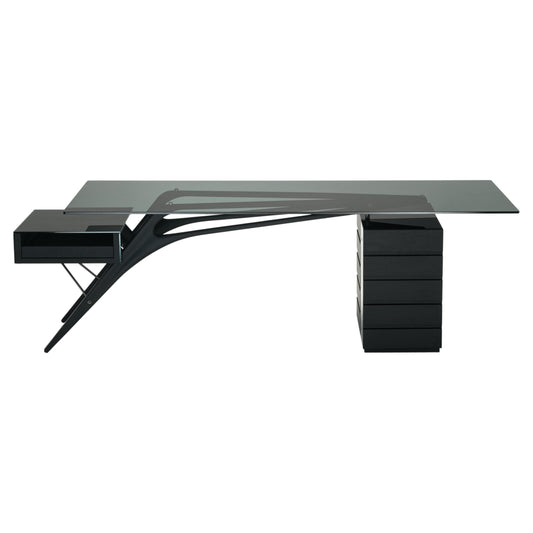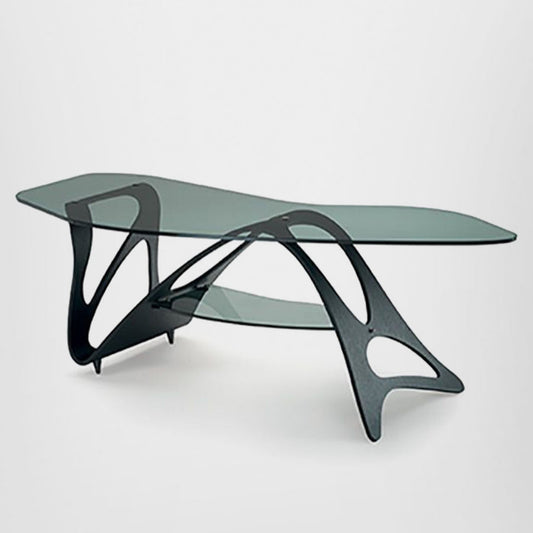컬렉션: Carlo Mollino
Carlo Mollino (Turin 1905-1973) was an architect, designer, photographer, writer, intellectual, and an aeroplane and automobile pilot. A complex and multifaceted figure on the 20th-century Italian scene, he embodied the model of the Renaissance artist, creating a personal and distinctive body of work unconnected to any of the era's groups and movements. The son of a building engineer, Mollino enrolled in the Engineering Faculty at Turin Polytechnic in 1924 but soon decided to transfer to the newly established Regia Scuola Superiore di Architettura. During his studies, the young architect worked alongside his father, developing a personal language that broke from the conventional style of the Mollino studio. In 1933, he won his first competition - for the headquarters of the Unione Provinciale Agricoltori - and in 1939 he completed his masterpiece, the building for the Società Ippica Torinese. His post-war career was eventful. He divided his time between architecture, product design, teaching at the Faculty of Architecture in Turin and writing numerous essays and books until 1953. After a six-year hiatus due to a deep personal crisis following his father's death, he resumed work, designing such projects as the Auditorium Rai in Turin, the Turin Chamber of Commerce, and the Regio Teatro dell'Opera. He died in 1973 while working alone in his studio.
It is not easy to classify Mollino's work within the history of art and architecture because of its distance from any of the commonly accepted currents. His innate eclecticism led him to explore all artistic expressions and styles, interpreting them according to his personal language. His work simultaneously contains futuristic, decadent, rationalist, surrealist, metaphysical and organic suggestions. His interior design and furniture are perhaps the most compelling aspects of his production. In 1936 he designed experimental interiors for his own home in Turin, called Casa Miller - a project that could be considered the manifesto of his thinking. For Mollino, the home is a unitary organism in which every component has equal importance. His interior designs sought to integrate spatial distribution and the creation of furniture and decoration to create an interconnected whole.
Consequently, most of his works were one-off pieces, also because Mollino was not interested in mass production.
If there is a characteristic trait of his furnishings, it is undoubtedly the combination of sinuous lines, disruptive elements, and sculptural elegance. Today, his furniture is exhibited in the permanent collections of MoMA in New York and the Victoria & Albert Museum in London. Collectors compete in exclusive auctions for the rare Mollino-designed objects remaining on the market. Thanks to its founder Aurelio, Zanotta incorporated some of Mollino's works into its catalogue starting in the 1980s. These include the famous Arabesco (1949) and Reale (1948) tables, the Cavour desk (1949), the Ardea armchair (1946) and the Milo mirror (1938).
-
CAVOUR CM - Writing desk with drawers
공급업체:Zanotta주문제작 유럽도매가 해상운송 6개월~지금 이 가격은 배송비와 세금이 빠진 금액입니다. 최종 가격은 결제 화면에서 주소지를 입력한 뒤에 확인 가능합니다.정가 ₩17,220,000 KRW에서정가₩30,640,000 KRW할인가 ₩17,220,000 KRW에서할인 -
REALE CM 2320 - Crystal table (Request Info)
공급업체:Zanotta주문제작 유럽도매가 해상운송 6개월~지금 이 가격은 배송비와 세금이 빠진 금액입니다. 최종 가격은 결제 화면에서 주소지를 입력한 뒤에 확인 가능합니다.가격문의 -
REALE 2320 - Crystal or marble table (Request Info)
공급업체:Zanotta주문제작 유럽도매가 해상운송 6개월~지금 이 가격은 배송비와 세금이 빠진 금액입니다. 최종 가격은 결제 화면에서 주소지를 입력한 뒤에 확인 가능합니다.가격문의 -
GILDA CM 888 - Reclining armchair in fabric or leather (Request Info)
공급업체:Zanotta주문제작 유럽도매가 해상운송 6개월~지금 이 가격은 배송비와 세금이 빠진 금액입니다. 최종 가격은 결제 화면에서 주소지를 입력한 뒤에 확인 가능합니다.가격문의 -
ARDEA CM 882 - Bergere armchair upholstered in fabric or leather (Request Info)
공급업체:Zanotta주문제작 유럽도매가 해상운송 6개월~지금 이 가격은 배송비와 세금이 빠진 금액입니다. 최종 가격은 결제 화면에서 주소지를 입력한 뒤에 확인 가능합니다.가격문의 -
ARABESCO CM - Crystal coffee table for living room
공급업체:Zanotta주문제작 유럽도매가 해상운송 6개월~지금 이 가격은 배송비와 세금이 빠진 금액입니다. 최종 가격은 결제 화면에서 주소지를 입력한 뒤에 확인 가능합니다.정가 ₩3,962,000 KRW정가₩7,924,000 KRW할인가 ₩3,962,000 KRW할인 -
MILO CM - Mirror (Request Info)
공급업체:Zanotta주문제작 유럽도매가 해상운송 6개월~지금 이 가격은 배송비와 세금이 빠진 금액입니다. 최종 가격은 결제 화면에서 주소지를 입력한 뒤에 확인 가능합니다.가격문의 -
CARLINO CM - Service storage unit (Request Info)
공급업체:Zanotta주문제작 유럽도매가 해상운송 6개월~지금 이 가격은 배송비와 세금이 빠진 금액입니다. 최종 가격은 결제 화면에서 주소지를 입력한 뒤에 확인 가능합니다.가격문의 -
FENIS CM - Maple chair (Request Info)
공급업체:Zanotta주문제작 유럽도매가 해상운송 6개월~지금 이 가격은 배송비와 세금이 빠진 금액입니다. 최종 가격은 결제 화면에서 주소지를 입력한 뒤에 확인 가능합니다.가격문의











